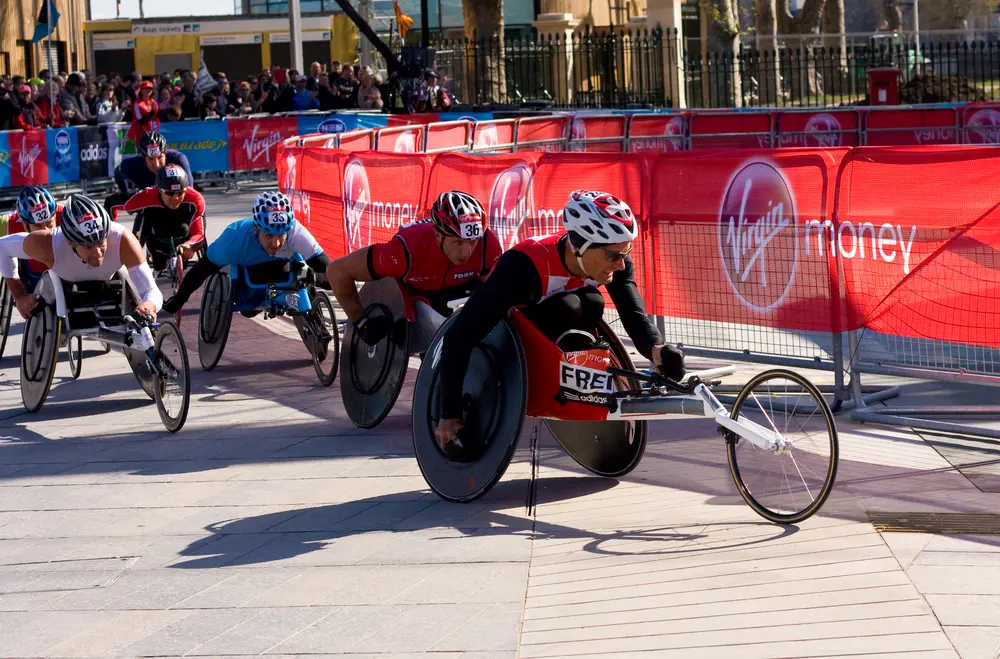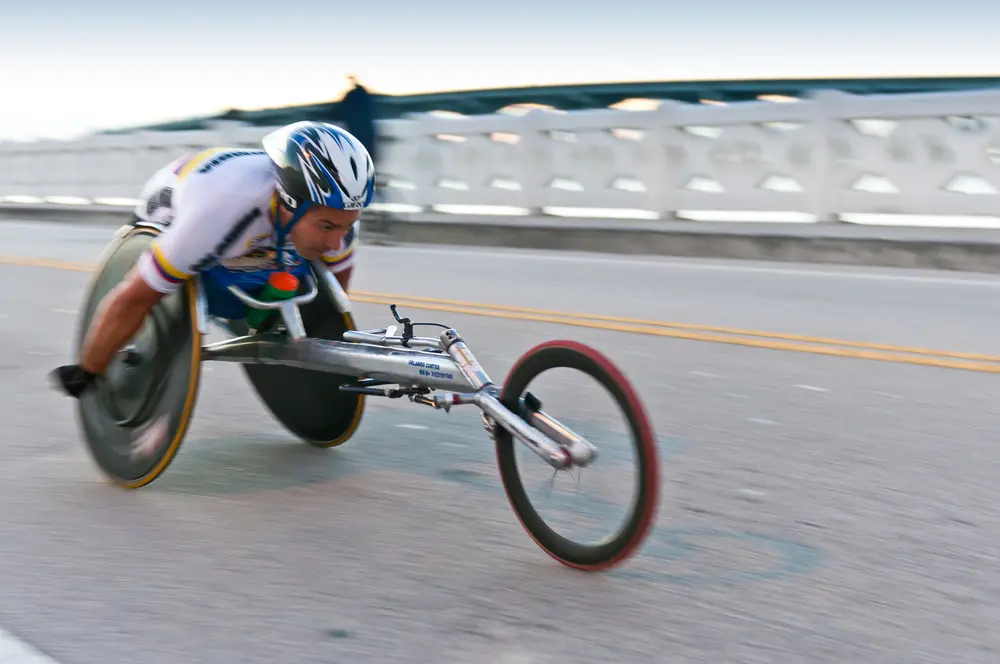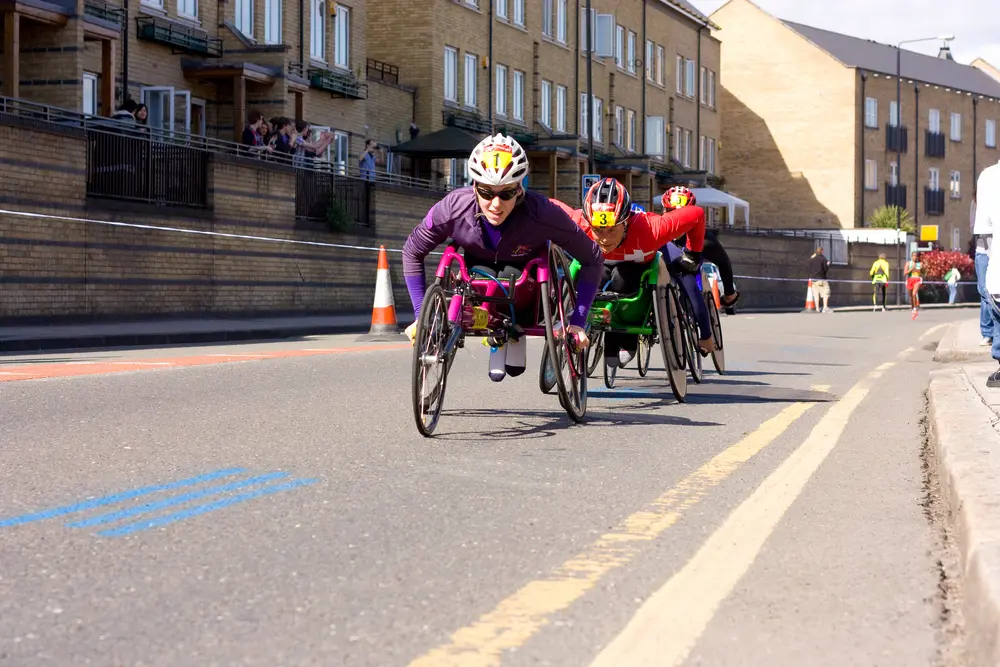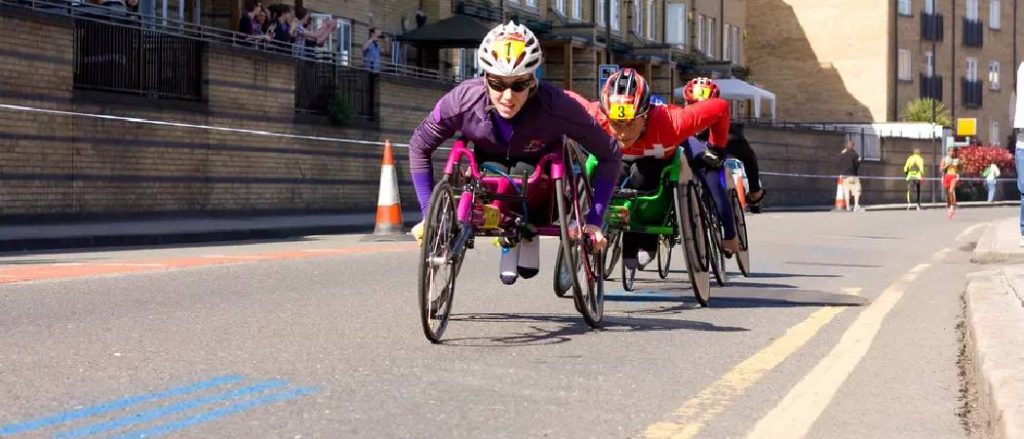If you use a wheelchair and seek a sport or recreation that is exciting and good for your body, which will test your physical limits and provide an exciting experience?
If that’s the case, maybe you’d be good at wheelchair racing.
Our article will discuss wheelchair racing as a sport for wheelchair users. Let’s look at wheelchair racing and see what makes it so interesting.

What You Need To Know About Wheelchair Racing
As the name implies, wheelchair racing features competitors using a wheelchair or racing chair to compete in road and track events. Individuals of any age or ability level can participate in wheelchair racing. It can be divided into two kinds for ease,
- Simple wheelchair racing is an inclusive recreational or non-competitive sport for people with limited mobility. It entails racing in a basic wheelchair, propelled manually, and may happen at local events or fun runs.
A video of a simple wheelchair race down the hill for recreation
- Athletic wheelchair racing is a highly competitive sport recognized nationally and internationally. It involves athletes with advanced skills and a racing wheelchair to enhance speed, maneuverability, and performance. Athletes undergo rigorous training, follow strict rules, and compete for medals and records.
Who Can Participate in Wheelchair Racing?
People with amputations, spinal cord injuries, cerebral palsy, and impaired vision, along with other disabilities, are all considered disabled athletes and can participate in field wheelchair racing.
The level of an athlete’s impairment will determine their classification.
- T51 and T52– Athletes with restricted upper-limb movement, amputation, or SCI
- T53 – Athletes with limited movement in their abdominals, as in lower-limb amputations or paraplegia
- T54 – Athletes with complete movement from the waist up, as in lower-limb amputations, complete or incomplete paraplegia
- There are different rules for athletes with cerebral palsy. Their classes vary from T32 to T38.
Specialized Racing Wheelchairs
A racing wheelchair has three training wheels but no mechanical gears; athletes must use only their upper limbs and body power to propel it. As long as they don’t break the regulations, athletes can modify their equipment to better suit their needs. The custom-made racing chair allows competitors to attain speeds of 30 km/h or higher.
The racing wheelchair may be used in either a kneeling or semi-seated posture. The maximum height of the wheel from the ground is 50 cm (1.6 ft). The athletes used special rubber gloves, or 3D-printed handles or gloves, to hold the push-rim and move the chair forward.

Brett Gravatt, a wheelchair athlete, explains the features of the racing wheelchair.
Wheelchair racing is subject to the same rules and regulations as other sports to ensure the safety of competitors, field athletes, and spectators.
Wheelchair Racing Competitions
Wheelchair racing has been included in the Paralympic Games since 1960, quickly becoming the most popular event.
Both track and road courses are used for the competition, and just like the standard races, they also have various distances.
There are 100, 200, and 400-meter short-distance sprint races, middle-distance races for 800 and 1500 meters, and long-distance races of 5k and 10k runs.
Athletes competing may also prove their strength in grueling long-distance road races like marathons and relay races (4 x 100m, 4 x 400m).

Inspirational Wheelchair Racers
There have been a lot of remarkable athletes who have reached the highest levels of wheelchair racing.
One famous name is that of Canadian paralympic wheelchair racer Josh Cassidy, who beat the world record at the Boston Marathon in 2012. Later, he won three silver medals at the 2015 Parapan American Games and placed second in the 800, 1500, and 5000-meter events. Cassidy aspires to achieve athletic achievement and be a good example for others with disabilities.
Aaron “Wheelz” Fotheringham, a wheelchair athlete with Spina Bifida since childhood, has transformed from BMX and skateboarding competitions to becoming a world-known motocross athlete. He also has his name in the Guinness Book of World Records. Aron views his wheelchair as an asset: “People of all abilities can achieve their goals.” he says.
Tatyana McFadden is a ten-medal winner in wheelchair racing at the Paralympic Games. Due to her early struggles with physical limitations, she has learned not to take things for granted. She approaches life’s challenges with a level of maturity that belies her youth, and her sheer will to achieve is proof that you shouldn’t let anything stand in the way of your aspirations.
The video showcases Hongzhuan Zhou, one of the top T53 wheelchair racers in the world, who has won six Paralympic gold medals and seven world championships throughout his impressive career.
A novice turned athlete, Jami Gane, who has had a spinal injury since 2005, decided to participate in the Chester Half Marathon after seeing social media posts. Participating in marathons with other amateur and professional wheelchair athletes opened his world to a new group of friends, including escort runners who helped him. The new drive improved his mental state, physical health, and everyday life. Jane believes that if he can do it, anyone can, and even those with disabilities can motivate anyone in sports.
Another inspirational story, Natasha Price, talks about her background in racing, her passion for the sport, and the factors that keep her driven.
These people and the hundreds of other athletes competing have much to teach us about courage, confidence, and making the most of one’s life despite one’s disability.
How to Start Wheelchair Racing?
Joining a local wheelchair racing club or team is a great way to get started in the sport. These organizations provide knowledgeable instructors, state-of-the-art training facilities, a network of encouraging track and field athletes, and separate races for novices.
Some examples of such places include the Challenged Athletes Foundation (CAF), the Houston Marathon Foundation Wheelchair Racing Team in Texas, Angel City Sports in California, and ParaSport Spokane in Washington. Such organizations offer coaching, training, and competitive opportunities for all levels and abilities of wheelchair racers.
And, if you are interested, the website ahotu.com lists all wheelchair racing events happening in the USA.
Conclusion
People with mobility issues and restricted movement can enjoy pleasure and independence by participating in wheelchair racing or any other wheelchair sport, as it can be a gateway to many opportunities, whether your goal is professional competition, a pleasurable activity, or just exploration.

